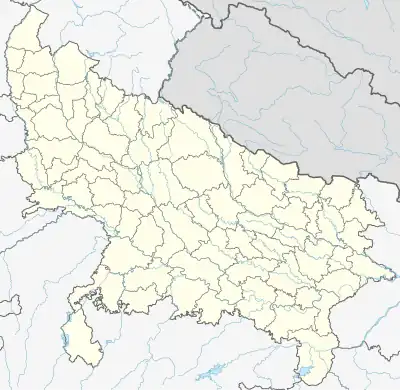Ugu
Ugu is a town and a nagar panchayat in Unnao district in the Indian state of Uttar Pradesh.[1] First officially classified as a town for the 1981 census,[2] Ugu is an old town with medieval ruins that hosts a biweekly market and an annual mela.[3] It is located on the main Unnao-Hardoi road, a bit northwest of Safipur.[3] Some of the main items manufactured here are shoes, slippers, furniture, and lipstick cover.[1] As of 2011, the population is 6,318, in 1,044 households.[1]
Ugu | |
|---|---|
Town | |
 Ugu Location in Uttar Pradesh, India | |
| Coordinates: 26.78°N 80.33°E | |
| State | Uttar Pradesh |
| District | Unnao |
| Founded by | Raja Ugarsen |
| Area | |
| • Total | 3 km2 (1 sq mi) |
| Elevation | 128 m (420 ft) |
| Population (2011) | |
| • Total | 6,318 |
| • Density | 2,100/km2 (5,500/sq mi) |
| Languages | |
| • Official | Hindi |
| Time zone | UTC+5:30 (IST) |
Over 90% of Ugu's population lives in slum conditions.[1] There are 10 slum areas in Ugu: Khetu, Manjhkhod North, Manjhkhod South, Newada East, Newada Middle, Newada West, Pakaria Chandi, Shuklana, Sonika, and Tarkhala.[1] These range from 89 to 99 households and have between 1 and 5 tap water access points.[1] The number of flush toilets installed in people's homes ranges from 4 to 65.[1] All 10 areas are serviced by open sewers.[1]
Ajay singh alias “Nangoo” was first chairman of Ugu town area.
History
Ugu is said to have been founded and populated by Raja Ugarsen, a Panwar Chhatri from Kannauj; the ruins of his palace and courthouse are still extant.[3] His descendants ruled here until 806 AH, when they were defeated and overthrown by Ibrahim Shah Sharqi of the Jaunpur Sultanate.[3] They were then replaced by Kurmi pattidars, who maintained possession of the village through the 20th century.[3]
At the turn of the 20th century, Ugu was described as a very large and prosperous village, "almost completely surrounded by groves".[3] It had a lower primary school attended by 60 students, as well as three temples and the ruins of Ugarsen's palace and courthouse.[3] Its population in 1901 was recorded as 4,640, including 4,443 Hindus and 197 Muslims.[3] Around 30% of the total population belonged to the Brahmin community.[3]
Demographics
| Year | Pop. | ±% |
|---|---|---|
| 1981 | 5,467 | — |
| 1991 | 5,915 | +8.2% |
| 2001 | 6,350 | +7.4% |
| 2011 | 6,318 | −0.5% |
| Source: 2011 Census of India[1] | ||
According to the 2001 Census of India, Ugu had a population of 6,359.[4]
The 2011 census recorded Ugu as having a population of 6,318 people, in 1,044 households.[1] 94.7% of the town's population was recorded as living in slum conditions.[1] The town's sex ratio is 852 females to every 1000 males, which is the lowest among towns in the district; 3,411 of Ugu's residents are male and 2,907 are female.[1] Among the 0-6 age group, the sex ratio is 696, also the lowest in the district and far below the district average of 903 for this group.[1] Members of Scheduled Castes make up 29.3% of the town's population, the second-highest proportion in the district behind Auras, while no members of scheduled tribes were recorded.[1] The town's literacy rate was 74.5% (counting only people age 7 and up); literacy was higher among men and boys (81.9%) than among women and girls (66.2%).[1]
In terms of employment, 25.0% of Ugu residents were classified as main workers (i.e. people employed for at least 6 months per year) in 2011.[1] Marginal workers (i.e. people employed for less than 6 months per year) made up 9.3%, and the remaining 65.8% were non-workers.[1] Employment status varied heavily according to gender, with 52.8% of men being either main or marginal workers, compared to only 12.5% of women.[1]
References
- "Census of India 2011: Uttar Pradesh District Census Handbook - Unnao, Part A (Village and Town Directory)". Census 2011 India. pp. 36–55, 63, 525–44. Retrieved 1 July 2021.
- Census 1981 Uttar Pradesh: District Census Handbook Part XIII-A: Village & Town Directory, District Unnao (PDF). 1982. pp. 15, 348–51. Retrieved 1 July 2021.
- Nevill, H.R. (1903). Unao: A Gazetteer, Being Volume XXXVIII Of The District Gazetteers Of The United Provinces Of Agra And Oudh. Allahabad: Government Press. p. 244. Retrieved 1 July 2021.
- "Data from the 2001 Census, including cities, villages and towns (Provisional)-Entry № 4879". Census of India 2001. Census Commission of India. Archived from the original on 16 June 2004. Retrieved 1 November 2008.